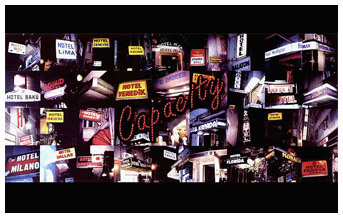


 |


launch interview with Hüseyin Bahri Alptekin
Trained in art and philosophy, Hüseyin Bahri Alptekin explores the narrow gap between the real and its reproduction, local realities and global fantasies, signifiers and signified, ideas and language, history and mythologies. He develops critical works that borrow the structure of language in order to analyze the phenomena of perception and the diffusion of knowledge. His works circle around the idea of signifying systems, their leeways and their limits in terms of translatability. His practice is rooted in historical precedents, including the international language of concrete poetry, which Alptekin appropriates in neon text, bending language and its untranslatability into something to be seen and something to be read.
His photo, text, and object collages, which often contain the cross-cultural detritus of world travel, reference common global anomalies such as cheap hotels with non-sequitor names of recognizable places and persons: Dallas, Tibet, Libya, Pele, Arafat, etc. Alptekin, a Baudelairian wanderer, creates symbolic tableaux--collaging language, objects, and images into an aesthetic of association that plays off of the tensions and heightened awareness that juxtaposition brings. He uses "coincidences," associative relationships, as a method to acknowledge that meaning is not in the structure of language itself but in the mind. Alptekin embraces the philosophical belief that the underlying principle that organizes meaningful systems is generated not by some inherent order to the world but by the subject and his or her own mind.
Alptekin was featured in Becoming a Place at Proje4L Istanbul Museum of Contemporary Art, Turkey (2001); the XXIV Bienal de São Paulo, Brazil (1998); and the Fourth Istanbul Biennial (1995). He has had numerous solo exhibitions including Kriz: Viva Vaia at the Dulcinea Gallery in Istanbul (1999).
--Philippe Vergne











